NURS2003 Case Study: Comprehensive Analysis of Pediatric Asthma
VerifiedAdded on 2023/06/15
|8
|2890
|98
Case Study
AI Summary
This case study provides an in-depth exploration of asthma in a five-year-old patient named Jessica, detailing the pathophysiology, symptoms, and pharmacological interventions used in her treatment. The study discusses the mechanisms of action of drugs like salbutamol, prednisolone, and ipratropium, explaining how these medications alleviate symptoms such as bronchoconstriction, inflammation, coughing, and wheezing. It also delves into the critical thinking and rationale behind the treatment approach, highlighting the importance of addressing both acute symptoms and chronic airway remodeling. The case study emphasizes the multifactorial nature of asthma and the need for comprehensive management strategies to improve patient outcomes. Desklib offers a platform to access similar solved assignments and study resources for students.
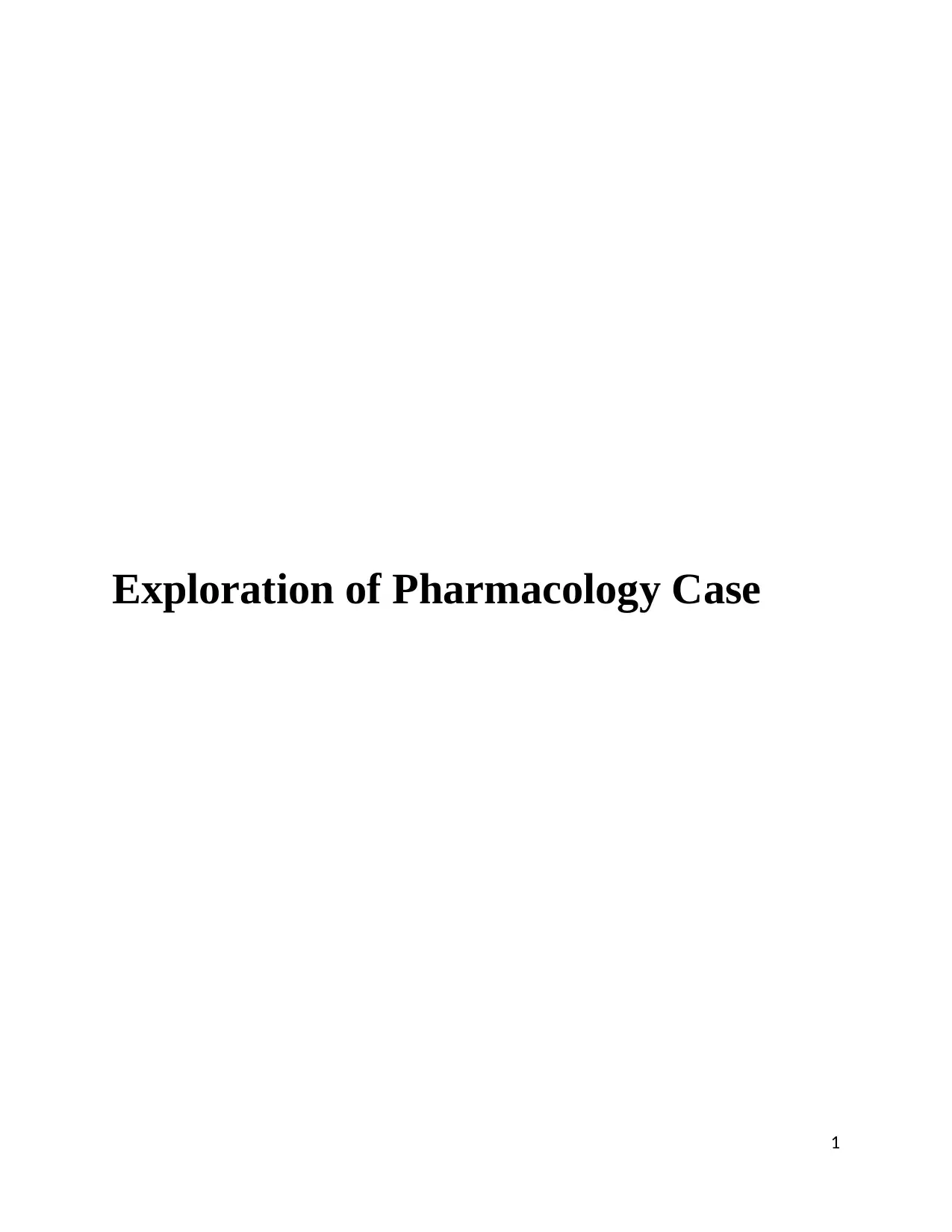
Exploration of Pharmacology Case
1
1
Paraphrase This Document
Need a fresh take? Get an instant paraphrase of this document with our AI Paraphraser
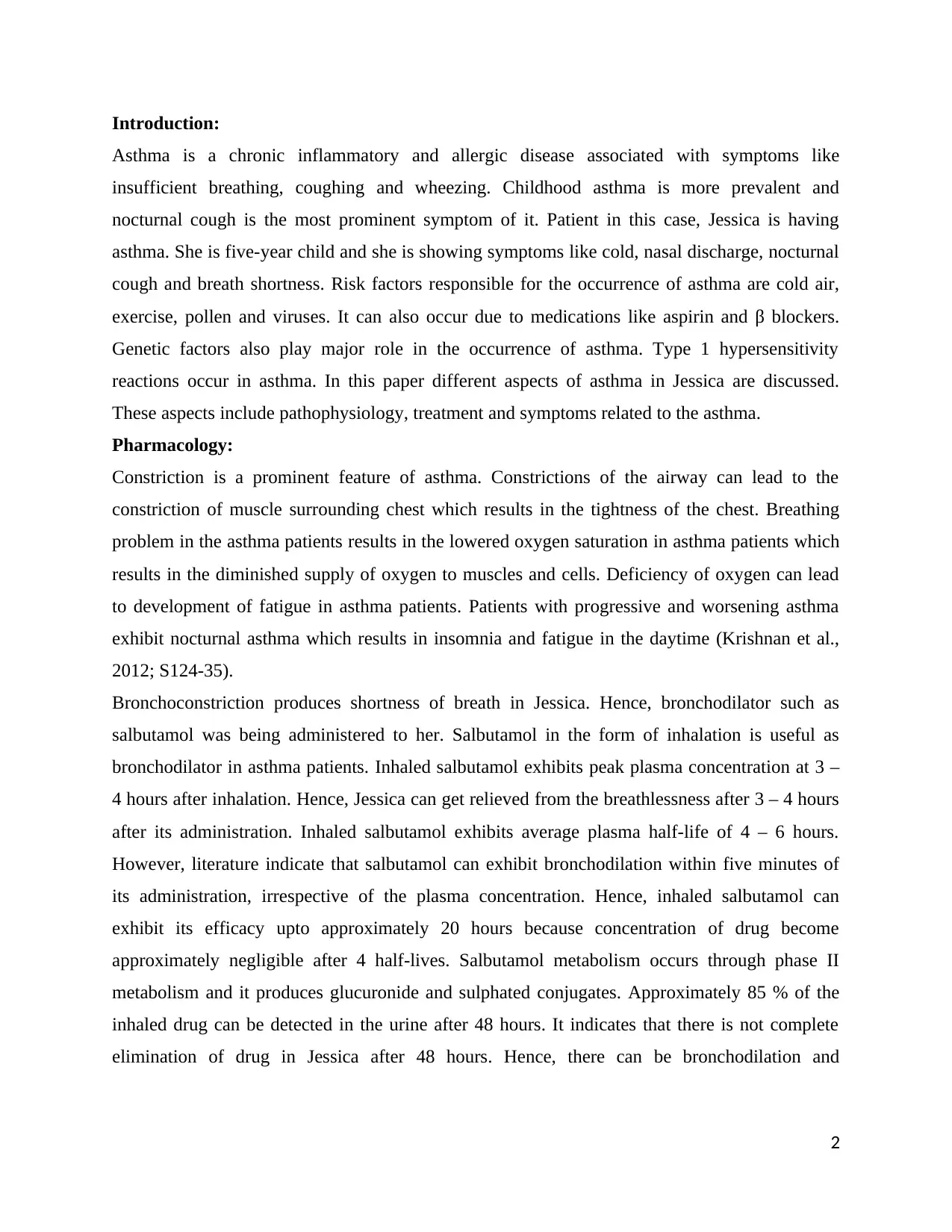
Introduction:
Asthma is a chronic inflammatory and allergic disease associated with symptoms like
insufficient breathing, coughing and wheezing. Childhood asthma is more prevalent and
nocturnal cough is the most prominent symptom of it. Patient in this case, Jessica is having
asthma. She is five-year child and she is showing symptoms like cold, nasal discharge, nocturnal
cough and breath shortness. Risk factors responsible for the occurrence of asthma are cold air,
exercise, pollen and viruses. It can also occur due to medications like aspirin and β blockers.
Genetic factors also play major role in the occurrence of asthma. Type 1 hypersensitivity
reactions occur in asthma. In this paper different aspects of asthma in Jessica are discussed.
These aspects include pathophysiology, treatment and symptoms related to the asthma.
Pharmacology:
Constriction is a prominent feature of asthma. Constrictions of the airway can lead to the
constriction of muscle surrounding chest which results in the tightness of the chest. Breathing
problem in the asthma patients results in the lowered oxygen saturation in asthma patients which
results in the diminished supply of oxygen to muscles and cells. Deficiency of oxygen can lead
to development of fatigue in asthma patients. Patients with progressive and worsening asthma
exhibit nocturnal asthma which results in insomnia and fatigue in the daytime (Krishnan et al.,
2012; S124-35).
Bronchoconstriction produces shortness of breath in Jessica. Hence, bronchodilator such as
salbutamol was being administered to her. Salbutamol in the form of inhalation is useful as
bronchodilator in asthma patients. Inhaled salbutamol exhibits peak plasma concentration at 3 –
4 hours after inhalation. Hence, Jessica can get relieved from the breathlessness after 3 – 4 hours
after its administration. Inhaled salbutamol exhibits average plasma half-life of 4 – 6 hours.
However, literature indicate that salbutamol can exhibit bronchodilation within five minutes of
its administration, irrespective of the plasma concentration. Hence, inhaled salbutamol can
exhibit its efficacy upto approximately 20 hours because concentration of drug become
approximately negligible after 4 half-lives. Salbutamol metabolism occurs through phase II
metabolism and it produces glucuronide and sulphated conjugates. Approximately 85 % of the
inhaled drug can be detected in the urine after 48 hours. It indicates that there is not complete
elimination of drug in Jessica after 48 hours. Hence, there can be bronchodilation and
2
Asthma is a chronic inflammatory and allergic disease associated with symptoms like
insufficient breathing, coughing and wheezing. Childhood asthma is more prevalent and
nocturnal cough is the most prominent symptom of it. Patient in this case, Jessica is having
asthma. She is five-year child and she is showing symptoms like cold, nasal discharge, nocturnal
cough and breath shortness. Risk factors responsible for the occurrence of asthma are cold air,
exercise, pollen and viruses. It can also occur due to medications like aspirin and β blockers.
Genetic factors also play major role in the occurrence of asthma. Type 1 hypersensitivity
reactions occur in asthma. In this paper different aspects of asthma in Jessica are discussed.
These aspects include pathophysiology, treatment and symptoms related to the asthma.
Pharmacology:
Constriction is a prominent feature of asthma. Constrictions of the airway can lead to the
constriction of muscle surrounding chest which results in the tightness of the chest. Breathing
problem in the asthma patients results in the lowered oxygen saturation in asthma patients which
results in the diminished supply of oxygen to muscles and cells. Deficiency of oxygen can lead
to development of fatigue in asthma patients. Patients with progressive and worsening asthma
exhibit nocturnal asthma which results in insomnia and fatigue in the daytime (Krishnan et al.,
2012; S124-35).
Bronchoconstriction produces shortness of breath in Jessica. Hence, bronchodilator such as
salbutamol was being administered to her. Salbutamol in the form of inhalation is useful as
bronchodilator in asthma patients. Inhaled salbutamol exhibits peak plasma concentration at 3 –
4 hours after inhalation. Hence, Jessica can get relieved from the breathlessness after 3 – 4 hours
after its administration. Inhaled salbutamol exhibits average plasma half-life of 4 – 6 hours.
However, literature indicate that salbutamol can exhibit bronchodilation within five minutes of
its administration, irrespective of the plasma concentration. Hence, inhaled salbutamol can
exhibit its efficacy upto approximately 20 hours because concentration of drug become
approximately negligible after 4 half-lives. Salbutamol metabolism occurs through phase II
metabolism and it produces glucuronide and sulphated conjugates. Approximately 85 % of the
inhaled drug can be detected in the urine after 48 hours. It indicates that there is not complete
elimination of drug in Jessica after 48 hours. Hence, there can be bronchodilation and
2
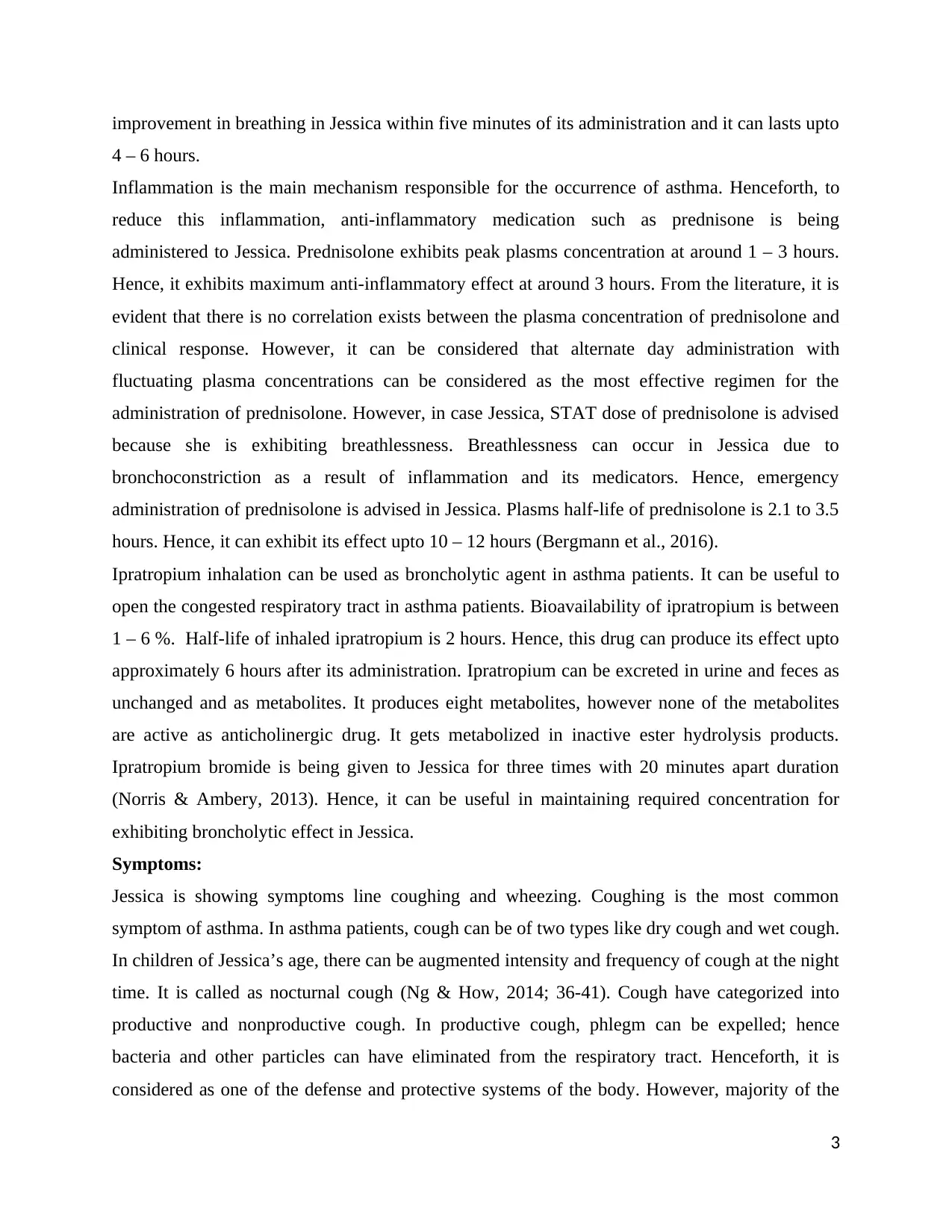
improvement in breathing in Jessica within five minutes of its administration and it can lasts upto
4 – 6 hours.
Inflammation is the main mechanism responsible for the occurrence of asthma. Henceforth, to
reduce this inflammation, anti-inflammatory medication such as prednisone is being
administered to Jessica. Prednisolone exhibits peak plasms concentration at around 1 – 3 hours.
Hence, it exhibits maximum anti-inflammatory effect at around 3 hours. From the literature, it is
evident that there is no correlation exists between the plasma concentration of prednisolone and
clinical response. However, it can be considered that alternate day administration with
fluctuating plasma concentrations can be considered as the most effective regimen for the
administration of prednisolone. However, in case Jessica, STAT dose of prednisolone is advised
because she is exhibiting breathlessness. Breathlessness can occur in Jessica due to
bronchoconstriction as a result of inflammation and its medicators. Hence, emergency
administration of prednisolone is advised in Jessica. Plasms half-life of prednisolone is 2.1 to 3.5
hours. Hence, it can exhibit its effect upto 10 – 12 hours (Bergmann et al., 2016).
Ipratropium inhalation can be used as broncholytic agent in asthma patients. It can be useful to
open the congested respiratory tract in asthma patients. Bioavailability of ipratropium is between
1 – 6 %. Half-life of inhaled ipratropium is 2 hours. Hence, this drug can produce its effect upto
approximately 6 hours after its administration. Ipratropium can be excreted in urine and feces as
unchanged and as metabolites. It produces eight metabolites, however none of the metabolites
are active as anticholinergic drug. It gets metabolized in inactive ester hydrolysis products.
Ipratropium bromide is being given to Jessica for three times with 20 minutes apart duration
(Norris & Ambery, 2013). Hence, it can be useful in maintaining required concentration for
exhibiting broncholytic effect in Jessica.
Symptoms:
Jessica is showing symptoms line coughing and wheezing. Coughing is the most common
symptom of asthma. In asthma patients, cough can be of two types like dry cough and wet cough.
In children of Jessica’s age, there can be augmented intensity and frequency of cough at the night
time. It is called as nocturnal cough (Ng & How, 2014; 36-41). Cough have categorized into
productive and nonproductive cough. In productive cough, phlegm can be expelled; hence
bacteria and other particles can have eliminated from the respiratory tract. Henceforth, it is
considered as one of the defense and protective systems of the body. However, majority of the
3
4 – 6 hours.
Inflammation is the main mechanism responsible for the occurrence of asthma. Henceforth, to
reduce this inflammation, anti-inflammatory medication such as prednisone is being
administered to Jessica. Prednisolone exhibits peak plasms concentration at around 1 – 3 hours.
Hence, it exhibits maximum anti-inflammatory effect at around 3 hours. From the literature, it is
evident that there is no correlation exists between the plasma concentration of prednisolone and
clinical response. However, it can be considered that alternate day administration with
fluctuating plasma concentrations can be considered as the most effective regimen for the
administration of prednisolone. However, in case Jessica, STAT dose of prednisolone is advised
because she is exhibiting breathlessness. Breathlessness can occur in Jessica due to
bronchoconstriction as a result of inflammation and its medicators. Hence, emergency
administration of prednisolone is advised in Jessica. Plasms half-life of prednisolone is 2.1 to 3.5
hours. Hence, it can exhibit its effect upto 10 – 12 hours (Bergmann et al., 2016).
Ipratropium inhalation can be used as broncholytic agent in asthma patients. It can be useful to
open the congested respiratory tract in asthma patients. Bioavailability of ipratropium is between
1 – 6 %. Half-life of inhaled ipratropium is 2 hours. Hence, this drug can produce its effect upto
approximately 6 hours after its administration. Ipratropium can be excreted in urine and feces as
unchanged and as metabolites. It produces eight metabolites, however none of the metabolites
are active as anticholinergic drug. It gets metabolized in inactive ester hydrolysis products.
Ipratropium bromide is being given to Jessica for three times with 20 minutes apart duration
(Norris & Ambery, 2013). Hence, it can be useful in maintaining required concentration for
exhibiting broncholytic effect in Jessica.
Symptoms:
Jessica is showing symptoms line coughing and wheezing. Coughing is the most common
symptom of asthma. In asthma patients, cough can be of two types like dry cough and wet cough.
In children of Jessica’s age, there can be augmented intensity and frequency of cough at the night
time. It is called as nocturnal cough (Ng & How, 2014; 36-41). Cough have categorized into
productive and nonproductive cough. In productive cough, phlegm can be expelled; hence
bacteria and other particles can have eliminated from the respiratory tract. Henceforth, it is
considered as one of the defense and protective systems of the body. However, majority of the
3
⊘ This is a preview!⊘
Do you want full access?
Subscribe today to unlock all pages.

Trusted by 1+ million students worldwide
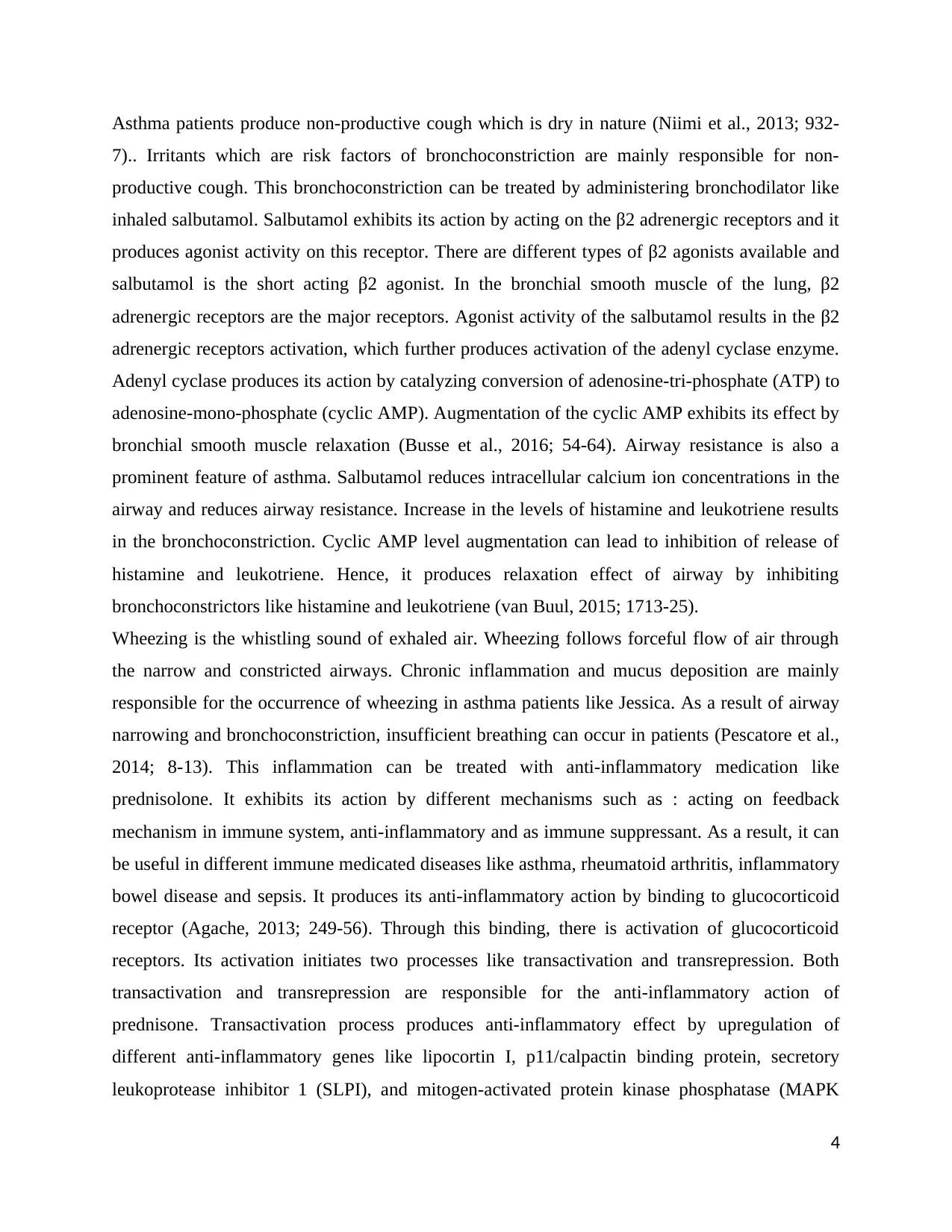
Asthma patients produce non-productive cough which is dry in nature (Niimi et al., 2013; 932-
7).. Irritants which are risk factors of bronchoconstriction are mainly responsible for non-
productive cough. This bronchoconstriction can be treated by administering bronchodilator like
inhaled salbutamol. Salbutamol exhibits its action by acting on the β2 adrenergic receptors and it
produces agonist activity on this receptor. There are different types of β2 agonists available and
salbutamol is the short acting β2 agonist. In the bronchial smooth muscle of the lung, β2
adrenergic receptors are the major receptors. Agonist activity of the salbutamol results in the β2
adrenergic receptors activation, which further produces activation of the adenyl cyclase enzyme.
Adenyl cyclase produces its action by catalyzing conversion of adenosine-tri-phosphate (ATP) to
adenosine-mono-phosphate (cyclic AMP). Augmentation of the cyclic AMP exhibits its effect by
bronchial smooth muscle relaxation (Busse et al., 2016; 54-64). Airway resistance is also a
prominent feature of asthma. Salbutamol reduces intracellular calcium ion concentrations in the
airway and reduces airway resistance. Increase in the levels of histamine and leukotriene results
in the bronchoconstriction. Cyclic AMP level augmentation can lead to inhibition of release of
histamine and leukotriene. Hence, it produces relaxation effect of airway by inhibiting
bronchoconstrictors like histamine and leukotriene (van Buul, 2015; 1713-25).
Wheezing is the whistling sound of exhaled air. Wheezing follows forceful flow of air through
the narrow and constricted airways. Chronic inflammation and mucus deposition are mainly
responsible for the occurrence of wheezing in asthma patients like Jessica. As a result of airway
narrowing and bronchoconstriction, insufficient breathing can occur in patients (Pescatore et al.,
2014; 8-13). This inflammation can be treated with anti-inflammatory medication like
prednisolone. It exhibits its action by different mechanisms such as : acting on feedback
mechanism in immune system, anti-inflammatory and as immune suppressant. As a result, it can
be useful in different immune medicated diseases like asthma, rheumatoid arthritis, inflammatory
bowel disease and sepsis. It produces its anti-inflammatory action by binding to glucocorticoid
receptor (Agache, 2013; 249-56). Through this binding, there is activation of glucocorticoid
receptors. Its activation initiates two processes like transactivation and transrepression. Both
transactivation and transrepression are responsible for the anti-inflammatory action of
prednisone. Transactivation process produces anti-inflammatory effect by upregulation of
different anti-inflammatory genes like lipocortin I, p11/calpactin binding protein, secretory
leukoprotease inhibitor 1 (SLPI), and mitogen-activated protein kinase phosphatase (MAPK
4
7).. Irritants which are risk factors of bronchoconstriction are mainly responsible for non-
productive cough. This bronchoconstriction can be treated by administering bronchodilator like
inhaled salbutamol. Salbutamol exhibits its action by acting on the β2 adrenergic receptors and it
produces agonist activity on this receptor. There are different types of β2 agonists available and
salbutamol is the short acting β2 agonist. In the bronchial smooth muscle of the lung, β2
adrenergic receptors are the major receptors. Agonist activity of the salbutamol results in the β2
adrenergic receptors activation, which further produces activation of the adenyl cyclase enzyme.
Adenyl cyclase produces its action by catalyzing conversion of adenosine-tri-phosphate (ATP) to
adenosine-mono-phosphate (cyclic AMP). Augmentation of the cyclic AMP exhibits its effect by
bronchial smooth muscle relaxation (Busse et al., 2016; 54-64). Airway resistance is also a
prominent feature of asthma. Salbutamol reduces intracellular calcium ion concentrations in the
airway and reduces airway resistance. Increase in the levels of histamine and leukotriene results
in the bronchoconstriction. Cyclic AMP level augmentation can lead to inhibition of release of
histamine and leukotriene. Hence, it produces relaxation effect of airway by inhibiting
bronchoconstrictors like histamine and leukotriene (van Buul, 2015; 1713-25).
Wheezing is the whistling sound of exhaled air. Wheezing follows forceful flow of air through
the narrow and constricted airways. Chronic inflammation and mucus deposition are mainly
responsible for the occurrence of wheezing in asthma patients like Jessica. As a result of airway
narrowing and bronchoconstriction, insufficient breathing can occur in patients (Pescatore et al.,
2014; 8-13). This inflammation can be treated with anti-inflammatory medication like
prednisolone. It exhibits its action by different mechanisms such as : acting on feedback
mechanism in immune system, anti-inflammatory and as immune suppressant. As a result, it can
be useful in different immune medicated diseases like asthma, rheumatoid arthritis, inflammatory
bowel disease and sepsis. It produces its anti-inflammatory action by binding to glucocorticoid
receptor (Agache, 2013; 249-56). Through this binding, there is activation of glucocorticoid
receptors. Its activation initiates two processes like transactivation and transrepression. Both
transactivation and transrepression are responsible for the anti-inflammatory action of
prednisone. Transactivation process produces anti-inflammatory effect by upregulation of
different anti-inflammatory genes like lipocortin I, p11/calpactin binding protein, secretory
leukoprotease inhibitor 1 (SLPI), and mitogen-activated protein kinase phosphatase (MAPK
4
Paraphrase This Document
Need a fresh take? Get an instant paraphrase of this document with our AI Paraphraser
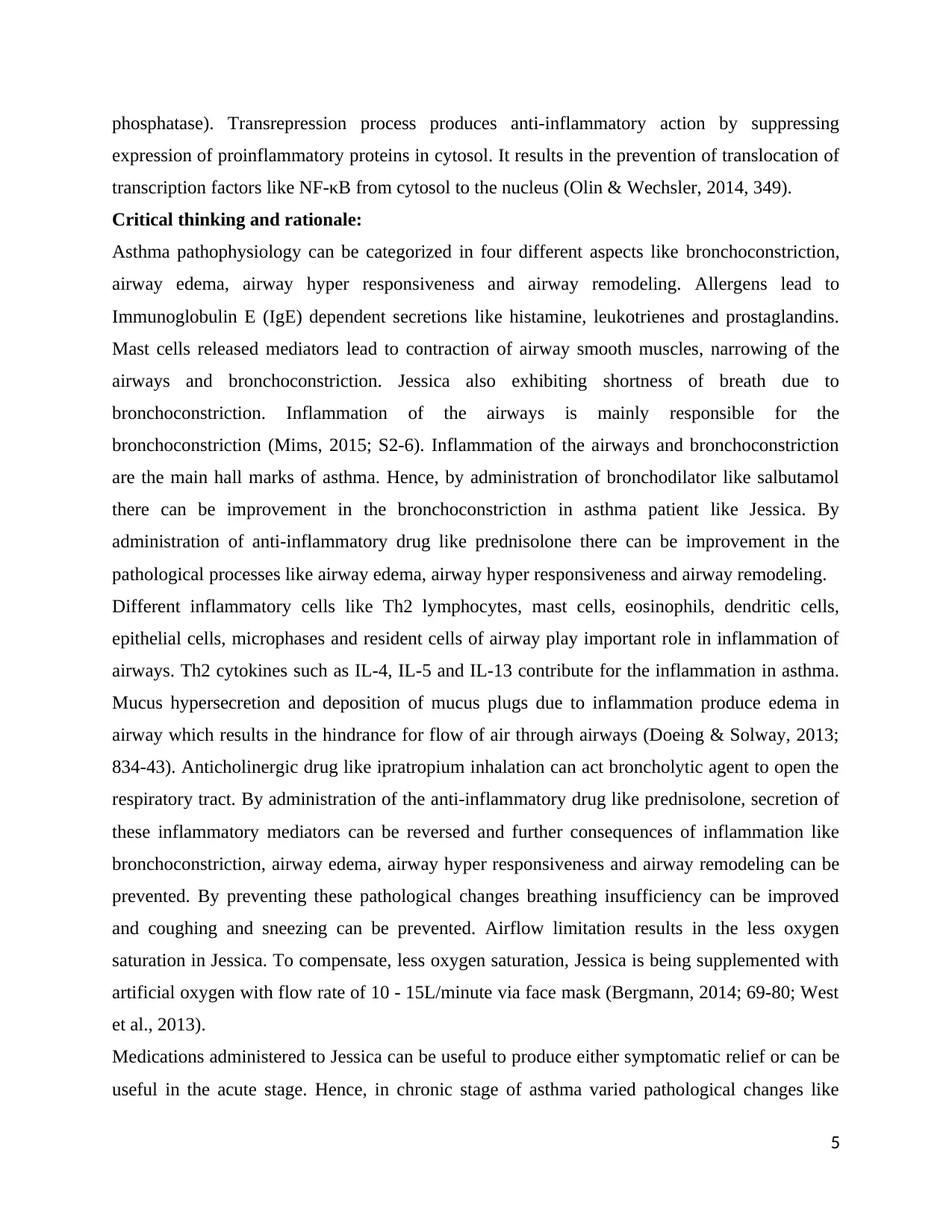
phosphatase). Transrepression process produces anti-inflammatory action by suppressing
expression of proinflammatory proteins in cytosol. It results in the prevention of translocation of
transcription factors like NF-κB from cytosol to the nucleus (Olin & Wechsler, 2014, 349).
Critical thinking and rationale:
Asthma pathophysiology can be categorized in four different aspects like bronchoconstriction,
airway edema, airway hyper responsiveness and airway remodeling. Allergens lead to
Immunoglobulin E (IgE) dependent secretions like histamine, leukotrienes and prostaglandins.
Mast cells released mediators lead to contraction of airway smooth muscles, narrowing of the
airways and bronchoconstriction. Jessica also exhibiting shortness of breath due to
bronchoconstriction. Inflammation of the airways is mainly responsible for the
bronchoconstriction (Mims, 2015; S2-6). Inflammation of the airways and bronchoconstriction
are the main hall marks of asthma. Hence, by administration of bronchodilator like salbutamol
there can be improvement in the bronchoconstriction in asthma patient like Jessica. By
administration of anti-inflammatory drug like prednisolone there can be improvement in the
pathological processes like airway edema, airway hyper responsiveness and airway remodeling.
Different inflammatory cells like Th2 lymphocytes, mast cells, eosinophils, dendritic cells,
epithelial cells, microphases and resident cells of airway play important role in inflammation of
airways. Th2 cytokines such as IL-4, IL-5 and IL-13 contribute for the inflammation in asthma.
Mucus hypersecretion and deposition of mucus plugs due to inflammation produce edema in
airway which results in the hindrance for flow of air through airways (Doeing & Solway, 2013;
834-43). Anticholinergic drug like ipratropium inhalation can act broncholytic agent to open the
respiratory tract. By administration of the anti-inflammatory drug like prednisolone, secretion of
these inflammatory mediators can be reversed and further consequences of inflammation like
bronchoconstriction, airway edema, airway hyper responsiveness and airway remodeling can be
prevented. By preventing these pathological changes breathing insufficiency can be improved
and coughing and sneezing can be prevented. Airflow limitation results in the less oxygen
saturation in Jessica. To compensate, less oxygen saturation, Jessica is being supplemented with
artificial oxygen with flow rate of 10 - 15L/minute via face mask (Bergmann, 2014; 69-80; West
et al., 2013).
Medications administered to Jessica can be useful to produce either symptomatic relief or can be
useful in the acute stage. Hence, in chronic stage of asthma varied pathological changes like
5
expression of proinflammatory proteins in cytosol. It results in the prevention of translocation of
transcription factors like NF-κB from cytosol to the nucleus (Olin & Wechsler, 2014, 349).
Critical thinking and rationale:
Asthma pathophysiology can be categorized in four different aspects like bronchoconstriction,
airway edema, airway hyper responsiveness and airway remodeling. Allergens lead to
Immunoglobulin E (IgE) dependent secretions like histamine, leukotrienes and prostaglandins.
Mast cells released mediators lead to contraction of airway smooth muscles, narrowing of the
airways and bronchoconstriction. Jessica also exhibiting shortness of breath due to
bronchoconstriction. Inflammation of the airways is mainly responsible for the
bronchoconstriction (Mims, 2015; S2-6). Inflammation of the airways and bronchoconstriction
are the main hall marks of asthma. Hence, by administration of bronchodilator like salbutamol
there can be improvement in the bronchoconstriction in asthma patient like Jessica. By
administration of anti-inflammatory drug like prednisolone there can be improvement in the
pathological processes like airway edema, airway hyper responsiveness and airway remodeling.
Different inflammatory cells like Th2 lymphocytes, mast cells, eosinophils, dendritic cells,
epithelial cells, microphases and resident cells of airway play important role in inflammation of
airways. Th2 cytokines such as IL-4, IL-5 and IL-13 contribute for the inflammation in asthma.
Mucus hypersecretion and deposition of mucus plugs due to inflammation produce edema in
airway which results in the hindrance for flow of air through airways (Doeing & Solway, 2013;
834-43). Anticholinergic drug like ipratropium inhalation can act broncholytic agent to open the
respiratory tract. By administration of the anti-inflammatory drug like prednisolone, secretion of
these inflammatory mediators can be reversed and further consequences of inflammation like
bronchoconstriction, airway edema, airway hyper responsiveness and airway remodeling can be
prevented. By preventing these pathological changes breathing insufficiency can be improved
and coughing and sneezing can be prevented. Airflow limitation results in the less oxygen
saturation in Jessica. To compensate, less oxygen saturation, Jessica is being supplemented with
artificial oxygen with flow rate of 10 - 15L/minute via face mask (Bergmann, 2014; 69-80; West
et al., 2013).
Medications administered to Jessica can be useful to produce either symptomatic relief or can be
useful in the acute stage. Hence, in chronic stage of asthma varied pathological changes like
5
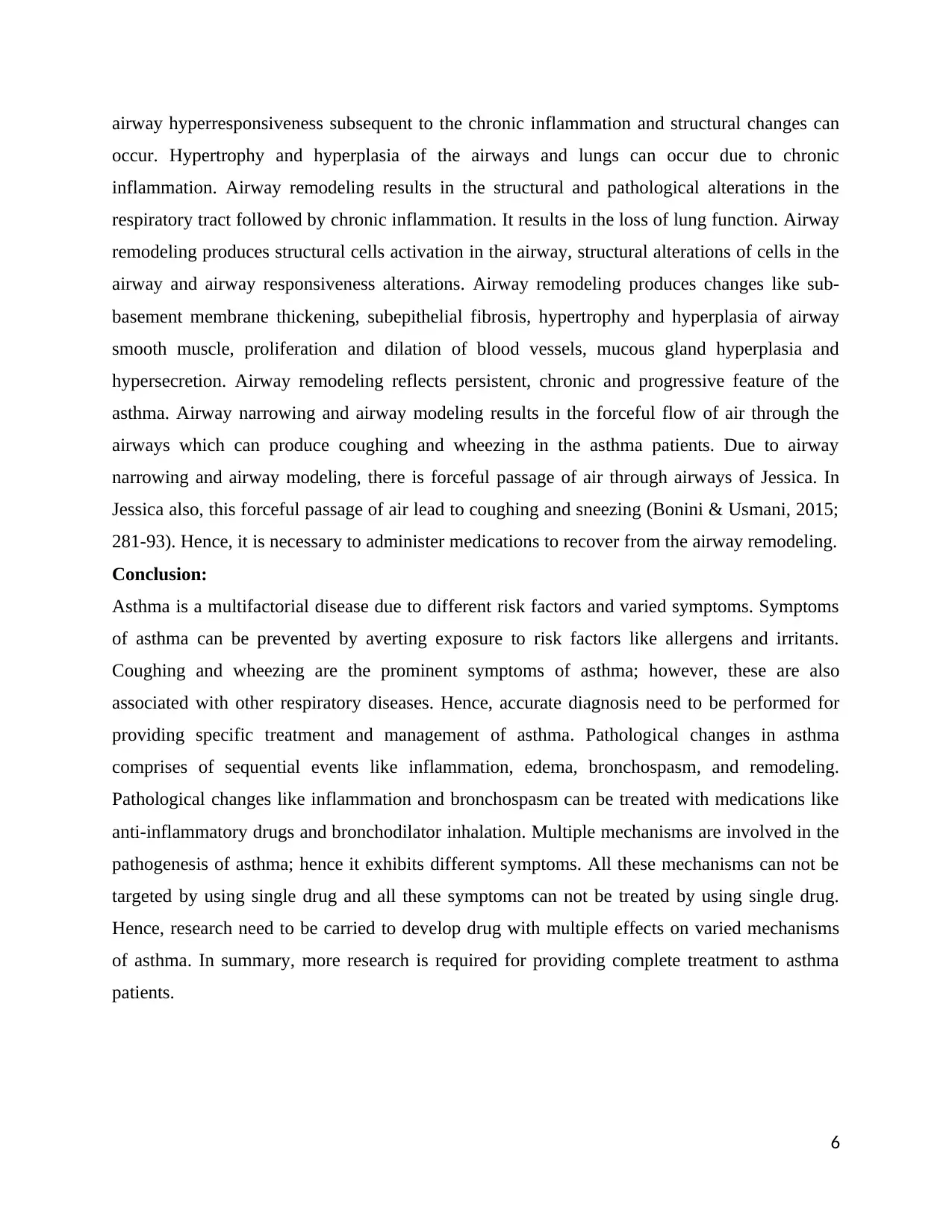
airway hyperresponsiveness subsequent to the chronic inflammation and structural changes can
occur. Hypertrophy and hyperplasia of the airways and lungs can occur due to chronic
inflammation. Airway remodeling results in the structural and pathological alterations in the
respiratory tract followed by chronic inflammation. It results in the loss of lung function. Airway
remodeling produces structural cells activation in the airway, structural alterations of cells in the
airway and airway responsiveness alterations. Airway remodeling produces changes like sub-
basement membrane thickening, subepithelial fibrosis, hypertrophy and hyperplasia of airway
smooth muscle, proliferation and dilation of blood vessels, mucous gland hyperplasia and
hypersecretion. Airway remodeling reflects persistent, chronic and progressive feature of the
asthma. Airway narrowing and airway modeling results in the forceful flow of air through the
airways which can produce coughing and wheezing in the asthma patients. Due to airway
narrowing and airway modeling, there is forceful passage of air through airways of Jessica. In
Jessica also, this forceful passage of air lead to coughing and sneezing (Bonini & Usmani, 2015;
281-93). Hence, it is necessary to administer medications to recover from the airway remodeling.
Conclusion:
Asthma is a multifactorial disease due to different risk factors and varied symptoms. Symptoms
of asthma can be prevented by averting exposure to risk factors like allergens and irritants.
Coughing and wheezing are the prominent symptoms of asthma; however, these are also
associated with other respiratory diseases. Hence, accurate diagnosis need to be performed for
providing specific treatment and management of asthma. Pathological changes in asthma
comprises of sequential events like inflammation, edema, bronchospasm, and remodeling.
Pathological changes like inflammation and bronchospasm can be treated with medications like
anti-inflammatory drugs and bronchodilator inhalation. Multiple mechanisms are involved in the
pathogenesis of asthma; hence it exhibits different symptoms. All these mechanisms can not be
targeted by using single drug and all these symptoms can not be treated by using single drug.
Hence, research need to be carried to develop drug with multiple effects on varied mechanisms
of asthma. In summary, more research is required for providing complete treatment to asthma
patients.
6
occur. Hypertrophy and hyperplasia of the airways and lungs can occur due to chronic
inflammation. Airway remodeling results in the structural and pathological alterations in the
respiratory tract followed by chronic inflammation. It results in the loss of lung function. Airway
remodeling produces structural cells activation in the airway, structural alterations of cells in the
airway and airway responsiveness alterations. Airway remodeling produces changes like sub-
basement membrane thickening, subepithelial fibrosis, hypertrophy and hyperplasia of airway
smooth muscle, proliferation and dilation of blood vessels, mucous gland hyperplasia and
hypersecretion. Airway remodeling reflects persistent, chronic and progressive feature of the
asthma. Airway narrowing and airway modeling results in the forceful flow of air through the
airways which can produce coughing and wheezing in the asthma patients. Due to airway
narrowing and airway modeling, there is forceful passage of air through airways of Jessica. In
Jessica also, this forceful passage of air lead to coughing and sneezing (Bonini & Usmani, 2015;
281-93). Hence, it is necessary to administer medications to recover from the airway remodeling.
Conclusion:
Asthma is a multifactorial disease due to different risk factors and varied symptoms. Symptoms
of asthma can be prevented by averting exposure to risk factors like allergens and irritants.
Coughing and wheezing are the prominent symptoms of asthma; however, these are also
associated with other respiratory diseases. Hence, accurate diagnosis need to be performed for
providing specific treatment and management of asthma. Pathological changes in asthma
comprises of sequential events like inflammation, edema, bronchospasm, and remodeling.
Pathological changes like inflammation and bronchospasm can be treated with medications like
anti-inflammatory drugs and bronchodilator inhalation. Multiple mechanisms are involved in the
pathogenesis of asthma; hence it exhibits different symptoms. All these mechanisms can not be
targeted by using single drug and all these symptoms can not be treated by using single drug.
Hence, research need to be carried to develop drug with multiple effects on varied mechanisms
of asthma. In summary, more research is required for providing complete treatment to asthma
patients.
6
⊘ This is a preview!⊘
Do you want full access?
Subscribe today to unlock all pages.

Trusted by 1+ million students worldwide
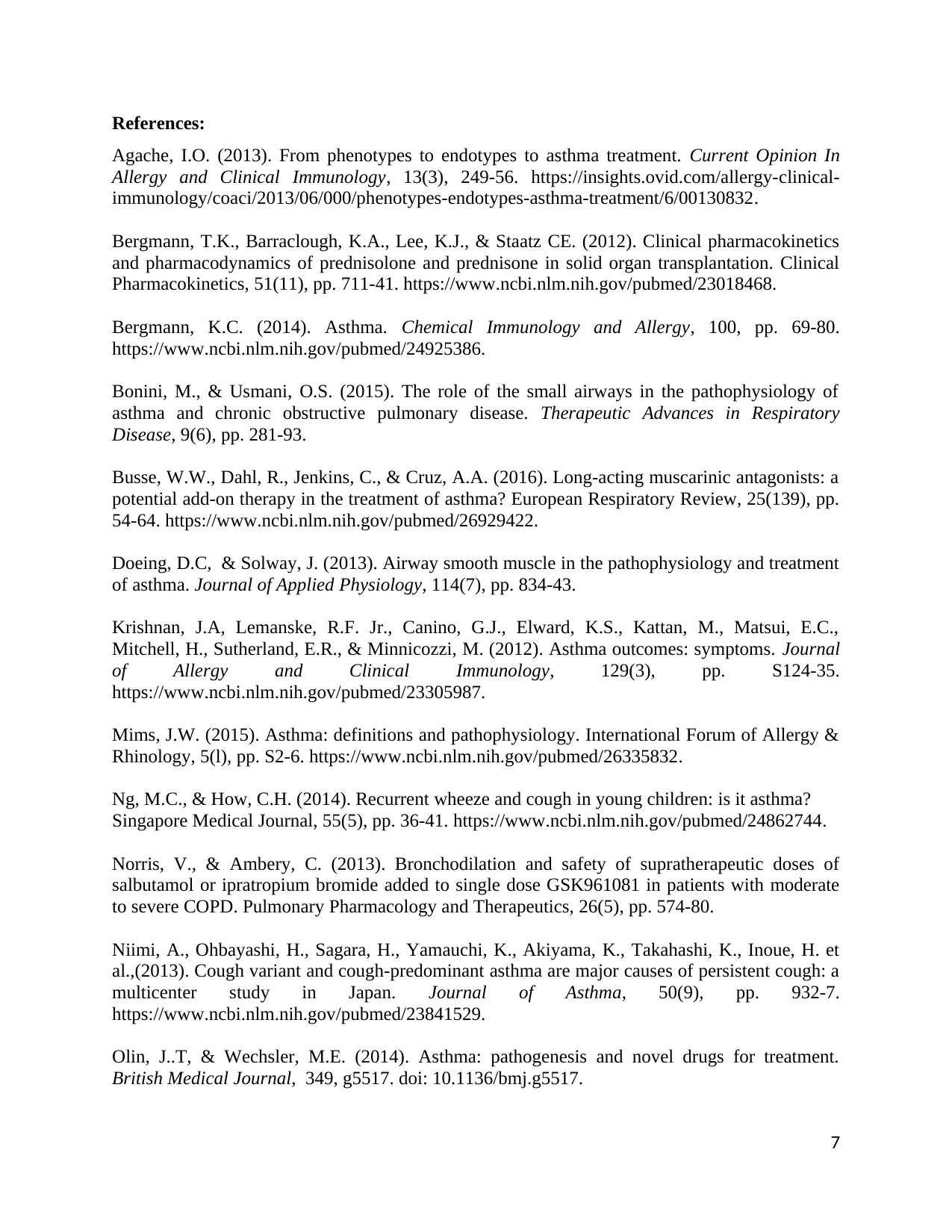
References:
Agache, I.O. (2013). From phenotypes to endotypes to asthma treatment. Current Opinion In
Allergy and Clinical Immunology, 13(3), 249-56. https://insights.ovid.com/allergy-clinical-
immunology/coaci/2013/06/000/phenotypes-endotypes-asthma-treatment/6/00130832.
Bergmann, T.K., Barraclough, K.A., Lee, K.J., & Staatz CE. (2012). Clinical pharmacokinetics
and pharmacodynamics of prednisolone and prednisone in solid organ transplantation. Clinical
Pharmacokinetics, 51(11), pp. 711-41. https://www.ncbi.nlm.nih.gov/pubmed/23018468.
Bergmann, K.C. (2014). Asthma. Chemical Immunology and Allergy, 100, pp. 69-80.
https://www.ncbi.nlm.nih.gov/pubmed/24925386.
Bonini, M., & Usmani, O.S. (2015). The role of the small airways in the pathophysiology of
asthma and chronic obstructive pulmonary disease. Therapeutic Advances in Respiratory
Disease, 9(6), pp. 281-93.
Busse, W.W., Dahl, R., Jenkins, C., & Cruz, A.A. (2016). Long-acting muscarinic antagonists: a
potential add-on therapy in the treatment of asthma? European Respiratory Review, 25(139), pp.
54-64. https://www.ncbi.nlm.nih.gov/pubmed/26929422.
Doeing, D.C, & Solway, J. (2013). Airway smooth muscle in the pathophysiology and treatment
of asthma. Journal of Applied Physiology, 114(7), pp. 834-43.
Krishnan, J.A, Lemanske, R.F. Jr., Canino, G.J., Elward, K.S., Kattan, M., Matsui, E.C.,
Mitchell, H., Sutherland, E.R., & Minnicozzi, M. (2012). Asthma outcomes: symptoms. Journal
of Allergy and Clinical Immunology, 129(3), pp. S124-35.
https://www.ncbi.nlm.nih.gov/pubmed/23305987.
Mims, J.W. (2015). Asthma: definitions and pathophysiology. International Forum of Allergy &
Rhinology, 5(l), pp. S2-6. https://www.ncbi.nlm.nih.gov/pubmed/26335832.
Ng, M.C., & How, C.H. (2014). Recurrent wheeze and cough in young children: is it asthma?
Singapore Medical Journal, 55(5), pp. 36-41. https://www.ncbi.nlm.nih.gov/pubmed/24862744.
Norris, V., & Ambery, C. (2013). Bronchodilation and safety of supratherapeutic doses of
salbutamol or ipratropium bromide added to single dose GSK961081 in patients with moderate
to severe COPD. Pulmonary Pharmacology and Therapeutics, 26(5), pp. 574-80.
Niimi, A., Ohbayashi, H., Sagara, H., Yamauchi, K., Akiyama, K., Takahashi, K., Inoue, H. et
al.,(2013). Cough variant and cough-predominant asthma are major causes of persistent cough: a
multicenter study in Japan. Journal of Asthma, 50(9), pp. 932-7.
https://www.ncbi.nlm.nih.gov/pubmed/23841529.
Olin, J..T, & Wechsler, M.E. (2014). Asthma: pathogenesis and novel drugs for treatment.
British Medical Journal, 349, g5517. doi: 10.1136/bmj.g5517.
7
Agache, I.O. (2013). From phenotypes to endotypes to asthma treatment. Current Opinion In
Allergy and Clinical Immunology, 13(3), 249-56. https://insights.ovid.com/allergy-clinical-
immunology/coaci/2013/06/000/phenotypes-endotypes-asthma-treatment/6/00130832.
Bergmann, T.K., Barraclough, K.A., Lee, K.J., & Staatz CE. (2012). Clinical pharmacokinetics
and pharmacodynamics of prednisolone and prednisone in solid organ transplantation. Clinical
Pharmacokinetics, 51(11), pp. 711-41. https://www.ncbi.nlm.nih.gov/pubmed/23018468.
Bergmann, K.C. (2014). Asthma. Chemical Immunology and Allergy, 100, pp. 69-80.
https://www.ncbi.nlm.nih.gov/pubmed/24925386.
Bonini, M., & Usmani, O.S. (2015). The role of the small airways in the pathophysiology of
asthma and chronic obstructive pulmonary disease. Therapeutic Advances in Respiratory
Disease, 9(6), pp. 281-93.
Busse, W.W., Dahl, R., Jenkins, C., & Cruz, A.A. (2016). Long-acting muscarinic antagonists: a
potential add-on therapy in the treatment of asthma? European Respiratory Review, 25(139), pp.
54-64. https://www.ncbi.nlm.nih.gov/pubmed/26929422.
Doeing, D.C, & Solway, J. (2013). Airway smooth muscle in the pathophysiology and treatment
of asthma. Journal of Applied Physiology, 114(7), pp. 834-43.
Krishnan, J.A, Lemanske, R.F. Jr., Canino, G.J., Elward, K.S., Kattan, M., Matsui, E.C.,
Mitchell, H., Sutherland, E.R., & Minnicozzi, M. (2012). Asthma outcomes: symptoms. Journal
of Allergy and Clinical Immunology, 129(3), pp. S124-35.
https://www.ncbi.nlm.nih.gov/pubmed/23305987.
Mims, J.W. (2015). Asthma: definitions and pathophysiology. International Forum of Allergy &
Rhinology, 5(l), pp. S2-6. https://www.ncbi.nlm.nih.gov/pubmed/26335832.
Ng, M.C., & How, C.H. (2014). Recurrent wheeze and cough in young children: is it asthma?
Singapore Medical Journal, 55(5), pp. 36-41. https://www.ncbi.nlm.nih.gov/pubmed/24862744.
Norris, V., & Ambery, C. (2013). Bronchodilation and safety of supratherapeutic doses of
salbutamol or ipratropium bromide added to single dose GSK961081 in patients with moderate
to severe COPD. Pulmonary Pharmacology and Therapeutics, 26(5), pp. 574-80.
Niimi, A., Ohbayashi, H., Sagara, H., Yamauchi, K., Akiyama, K., Takahashi, K., Inoue, H. et
al.,(2013). Cough variant and cough-predominant asthma are major causes of persistent cough: a
multicenter study in Japan. Journal of Asthma, 50(9), pp. 932-7.
https://www.ncbi.nlm.nih.gov/pubmed/23841529.
Olin, J..T, & Wechsler, M.E. (2014). Asthma: pathogenesis and novel drugs for treatment.
British Medical Journal, 349, g5517. doi: 10.1136/bmj.g5517.
7
Paraphrase This Document
Need a fresh take? Get an instant paraphrase of this document with our AI Paraphraser
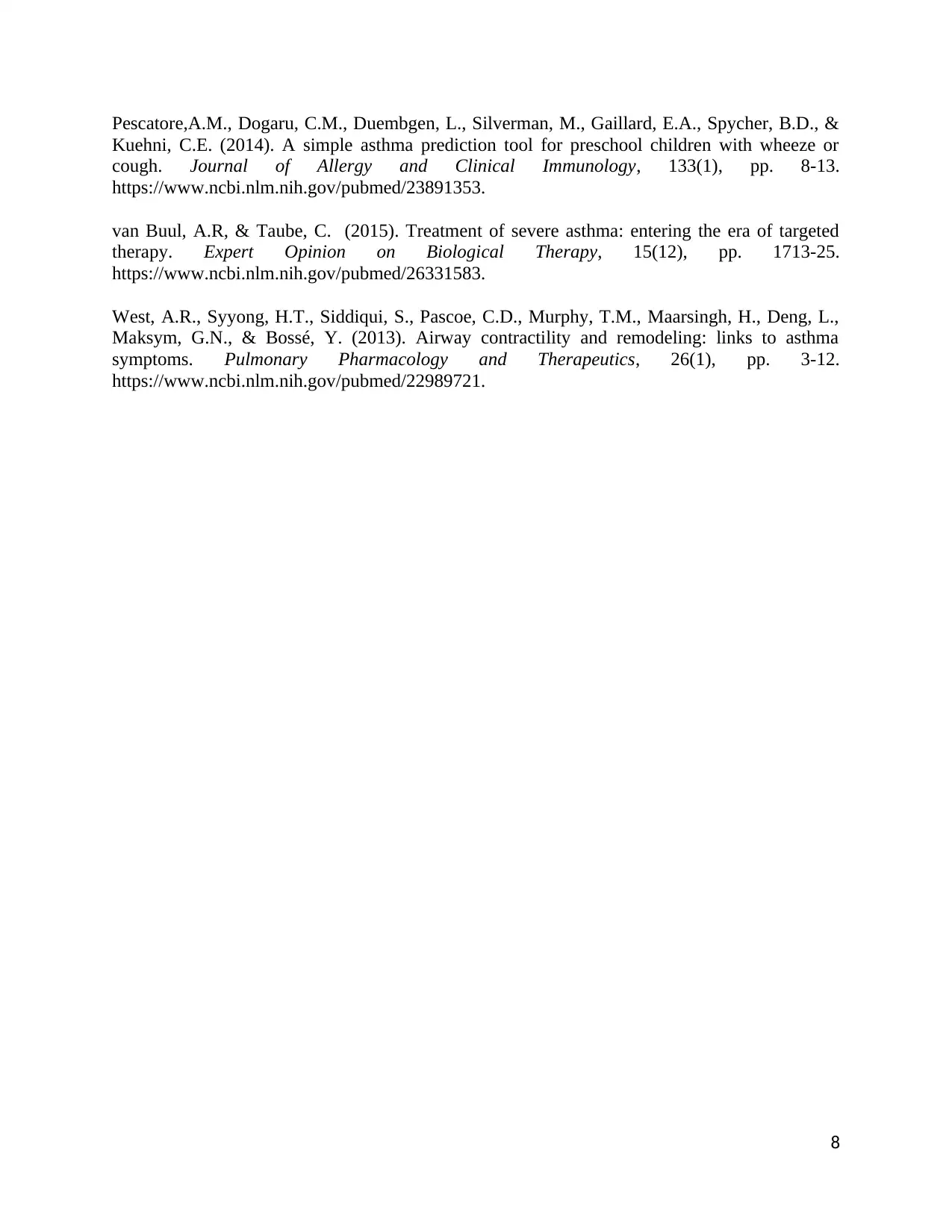
Pescatore,A.M., Dogaru, C.M., Duembgen, L., Silverman, M., Gaillard, E.A., Spycher, B.D., &
Kuehni, C.E. (2014). A simple asthma prediction tool for preschool children with wheeze or
cough. Journal of Allergy and Clinical Immunology, 133(1), pp. 8-13.
https://www.ncbi.nlm.nih.gov/pubmed/23891353.
van Buul, A.R, & Taube, C. (2015). Treatment of severe asthma: entering the era of targeted
therapy. Expert Opinion on Biological Therapy, 15(12), pp. 1713-25.
https://www.ncbi.nlm.nih.gov/pubmed/26331583.
West, A.R., Syyong, H.T., Siddiqui, S., Pascoe, C.D., Murphy, T.M., Maarsingh, H., Deng, L.,
Maksym, G.N., & Bossé, Y. (2013). Airway contractility and remodeling: links to asthma
symptoms. Pulmonary Pharmacology and Therapeutics, 26(1), pp. 3-12.
https://www.ncbi.nlm.nih.gov/pubmed/22989721.
8
Kuehni, C.E. (2014). A simple asthma prediction tool for preschool children with wheeze or
cough. Journal of Allergy and Clinical Immunology, 133(1), pp. 8-13.
https://www.ncbi.nlm.nih.gov/pubmed/23891353.
van Buul, A.R, & Taube, C. (2015). Treatment of severe asthma: entering the era of targeted
therapy. Expert Opinion on Biological Therapy, 15(12), pp. 1713-25.
https://www.ncbi.nlm.nih.gov/pubmed/26331583.
West, A.R., Syyong, H.T., Siddiqui, S., Pascoe, C.D., Murphy, T.M., Maarsingh, H., Deng, L.,
Maksym, G.N., & Bossé, Y. (2013). Airway contractility and remodeling: links to asthma
symptoms. Pulmonary Pharmacology and Therapeutics, 26(1), pp. 3-12.
https://www.ncbi.nlm.nih.gov/pubmed/22989721.
8
1 out of 8
Related Documents
Your All-in-One AI-Powered Toolkit for Academic Success.
+13062052269
info@desklib.com
Available 24*7 on WhatsApp / Email
![[object Object]](/_next/static/media/star-bottom.7253800d.svg)
Unlock your academic potential
Copyright © 2020–2025 A2Z Services. All Rights Reserved. Developed and managed by ZUCOL.





